
by Mary Caperton Morton Thursday, January 5, 2012
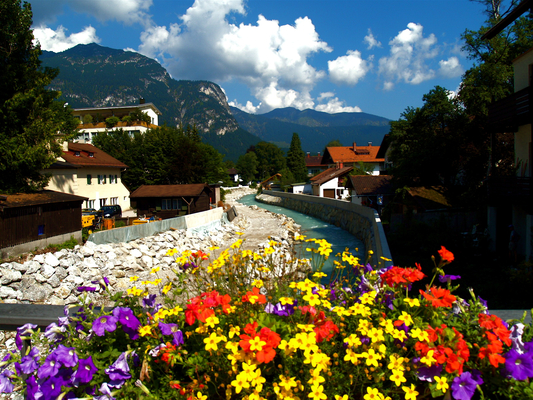
For a taste of classic Bavaria, head to Farchant, about 4.5 kilometers from Garmisch-Partenkirchen in the German Alps. Mary Caperton Morton
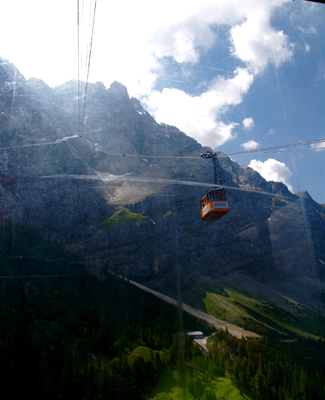
The Eibsee Aerial Tramway, a glass-bottomed cable car, carries visitors to the summit of the Zugspitze. Mary Caperton Morton
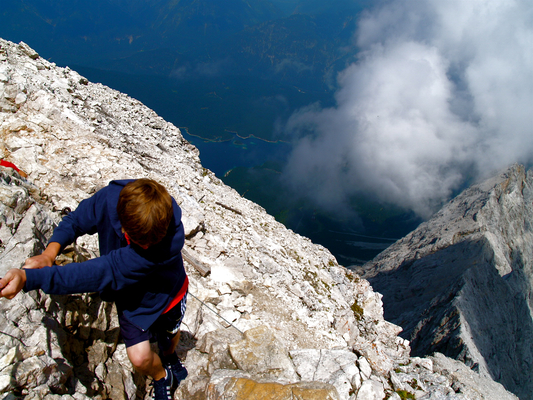
Crossing to the summit of the Zugspitze. Mary Caperton Morton
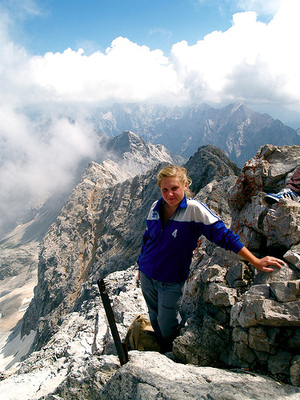
The author, climbing in the German Alps. Mary Caperton Morton
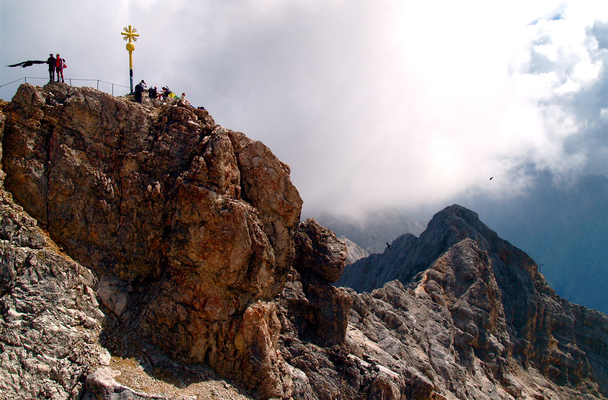
The summit of the Zugspitze - also the highest point in Germany - is marked by the gold cross. Mary Caperton Morton
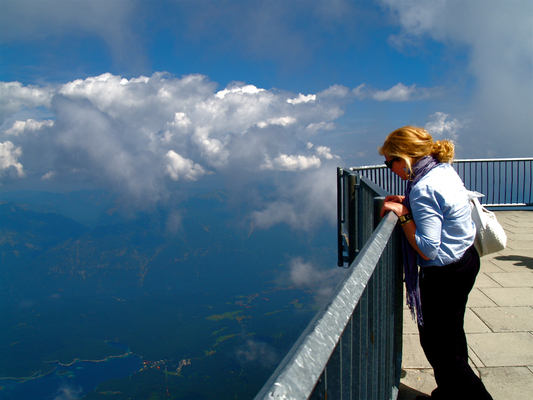
A viewing platform from the summit of the Zugspitze, looking out over the Eibsee Valley. Mary Caperton Morton
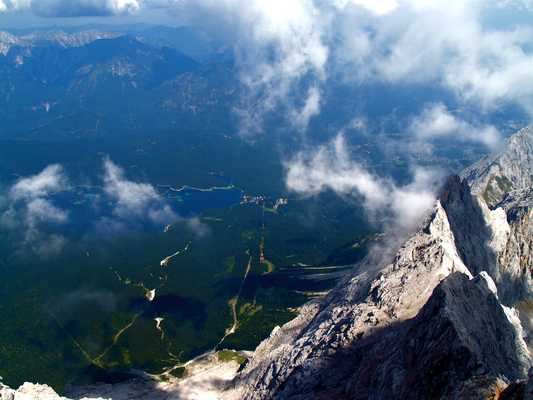
The glacially-fed Eibsee lake is shockingly blue and crystal-clear, and sits in the valley north of the Zugspitze. Mary Caperton Morton
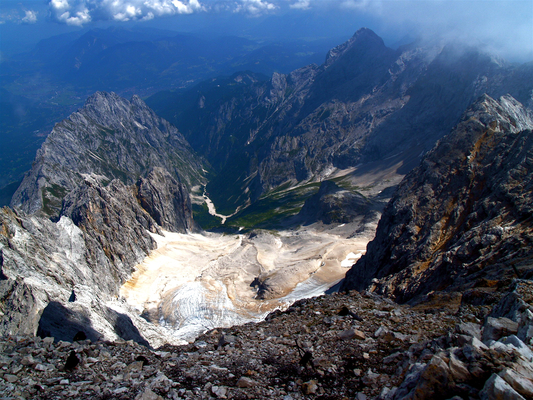
The Zugspitze glacier, one of Germany's most beloved natural features, is rapidly melting. Mary Caperton Morton
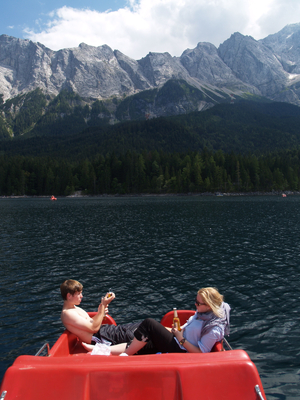
Relaxing in a paddleboat on the glacially-fed Eibsee Lake, with a panoramic view of the Alps above. Mary Caperton Morton
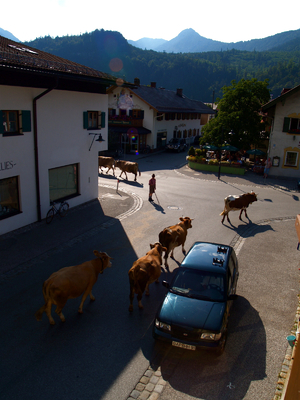
In the time-capsule town of Farchant, Germany, many of the locals still wear traditional lederhosen and herd their dairy cows through the cobblestone streets. Mary Caperton Morton
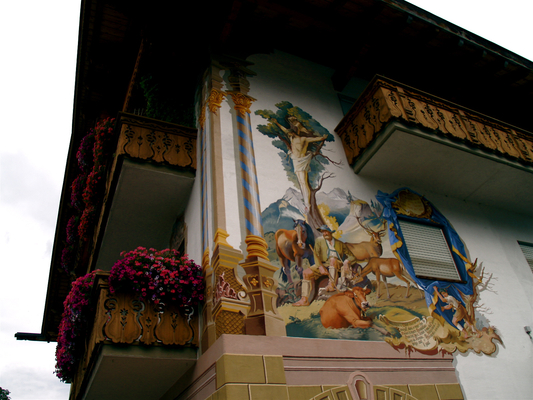
In Farchant, Germany, the timberframe houses are painted with colorful murals and flowerboxes perch on every window. Mary Caperton Morton
Mountaineers in the “High Points Club” have a lofty goal: to “tag,” or reach, the highest elevations of every country in the world. Many of the 193 summits are best left to the professionals, but at least one, the highest point in Germany, is accessible to anybody with a train ticket. At 2,962 meters, the Zugspitze towers over the German Alps. But unlike most alpine peaks, you don’t need ropes, crampons and ice axes to stand on the summit. The Zugspitzbahn, an old-fashioned cog wheel train, will take you all the way to the top.
Zugspitzbahn’s toothed rack-and-pinion railway was built for tourists in 1936, when the nearby town of Garmisch-Partenkirchen hosted the winter Olympics. Despite its modest size, Garmisch-Partenkirchen was a perfect venue for the winter games; this region is a snow-sports wonderland. The valley, in the Bavarian region of southern Germany, is surrounded by the Alps and has snow on the ground from October to May. Five ski resorts, 40 lifts and more than 70 kilometers of trails give skiers and snowboarders access to world-class ski slopes. Southern Bavaria’s not just for ski buffs though — this is one of the best places in Europe for mountaineers and non-climbers alike to reach out and touch the tops of the Alps.
A specially modified ski lift gives thrill-seeking visitors another way to tag Germany’s highest point. The Eibsee Aerial Tramway, a glass-bottomed cable car, takes about 10 minutes to gain 1,950 meters of elevation, affording hair-raising views of the slopes flashing by beneath your feet as you whiz to the top of the Zugspitze. At the summit you’ll find a visitors' center with displays in German and English, as well as Germany’s highest restaurant and chapel. An observation deck overlooks spectacular 360-degree views of the valley to the north and the Alps to the east, west and south. The summit of the Zugspitze is marked by a gold cross. If you’re feeling brave, a short but “airy” (in climbing terms, exposed with a steep drop) climb along steel cables bolted into the rock will take you over to the cross. Watch your step and keep a good grip on the cables — one slip could send you plunging off the mountain.
If you’re looking to join the High Points Club, you have to get to the top the old-fashioned way. The route isn’t very technical, but does require mountaineering experience, some equipment and a strong set of legs – the climb gains more than 2,200 meters of elevation. The most popular route starts in Hammersback, near Garmisch-Partenkirchen, and follows the aptly-named Höllental (Valley of Hell) Gorge. This climb is also aided by steel cables, which you have to clip into using a harness and carabiners, a climbing method known as via ferrata. The route is relentlessly steep and extremely exposed; even well-conditioned climbers take 2 days to reach the summit. Sleeping accommodations can be found along the way at two mountain huts, Höllentalangerhütte at 1,379 meters and Wiener Neustadterhütte at 2,209 meters elevation. The climb is well marked and altitude sickness is not likely to be a problem, but via ferrata experience is necessary. Novices are much better off riding to the top.
The summit of the Zugspitze teeters on the edge of Germany; Austria is a few steps to the east and the peaks of Switzerland and Italy are visible to the west and south. These mountains are all part of the Wetterstein massif, a range of peaks on the border between southern Germany and Austria. The mountains are made of limestone, formed from sediments deposited in the ancient Tethys Ocean basin about 200 million years ago, during the time of the dinosaurs. The Tethys separated the ancient supercontinents Laurasia (which included modern-day Europe) and Gondwana (which included modern-day Africa), until the African plate began to push northward into the Eurasian plate around 30 million years ago. That closed the Tethys and lifted the sea floor up, forming the Alps. The intense tectonic forces created massive recumbent folds in the limestone, called nappes, which were then carved extensively by glaciers over the past 2 million years to form the extreme peaks and valleys seen today.
Few of these glaciers still remain. Germany is left with only one, just below the summit of the Zugspitze. Photographs in the visitors’ center depict the dramatic change in the glacier, one of Germany’s most beloved natural features, over the past century. Thick snow and ice used to dominate the mountain, but what’s left looks more like a bowl of dirty snow. Measurements show the glacier had been reduced to less than half its thickness of 90 meters by 1910. Drastic measures are now being taken to slow the glacier’s melting. For the past 14 summers, 6,000 square meters of the glacier have been covered with white tarpaulins to shield the ice from the sun. The tarps aren’t an eyesore, however. The glacier sits several hundred meters below the mountain’s summit and even though I visited in August, I couldn’t make out the tarps. The desperate fight to save the Zugspitze glacier keeps going year-round: Every winter, dynamite is used to set off avalanches on the surrounding slopes to add snow to the dwindling glacier.
At least one of the area’s natural features is benefitting from increased melting: the glacially-fed Eibsee lake. This shockingly blue, crystal-clear lake sits in the valley north of the Zugspitze. Geologists have determined the lake was created by a massive landslide that dammed streams of meltwater cascading down the mountain. Today the two-and-a-half-kilometer-long, one-kilometer-wide lake is a popular recreation spot for boating, fishing and swimming. The four-star Eibsee Hotel and Resort, which sits between the lake and the mountains, rents canoes, kayaks and paddleboats for a few Euros an hour. Relaxing on the lake with the panoramic view of the Alps above was one of the best experiences I had on my trip to Europe.
If the Eibsee Hotel is booked, the surrounding towns provide many different options for places to stay. In Garmisch-Partenkirchen you’ll find more modern hotels with English speaking staffs, but if you’re looking for a taste of classic Bavaria, head to nearby Farchant. This little town, a short bus ride away from the Zugspitze, is a time capsule. Many of the locals still wear traditional lederhosen and herd their dairy cows through the cobblestone streets. Farchant’s timberframe houses are painted with colorful murals and flowerboxes perch on every window. My high school German was pushed to the limits here — nobody spoke English but the townspeople were helpful, patient and über-friendly.
Germans love their vacations — they get at least 35 days off work a year — and the Zugspitze is one of Bavaria’s most popular destinations. Located 97 kilometers south of Munich, the region is perhaps best known for its winter sports, but summer is also beautiful and many ski lifts, including the Zugspitze tramway, remain open year round to ferry hikers into the Alps.
© 2008-2021. All rights reserved. Any copying, redistribution or retransmission of any of the contents of this service without the expressed written permission of the American Geosciences Institute is expressly prohibited. Click here for all copyright requests.